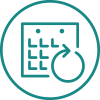

POCT Glucose and Ketones


POCT Glucose and Ketones
Purpose:
The measurement of capillary blood glucose using Point of Care Testing (POCT) devices is widespread across the UK, Europe and North America; with the NHS in the UK spending £165 M in primary care and £16.7 M in secondary care in 2018/ 19 on POCT devices and strips.
In secondary care POCT blood glucose monitoring is used primarily for the management of patients at risk of hyperglycaemia and hypoglycaemia such as diabetic patients, stress induced acute hyperglycaemia in critically ill patients and the diagnosis of hypoglycaemia in neonates. It is generally accepted that extremes of inpatient hyperglycaemia and hypoglycaemia have the potential to affect patient outcome negatively. Blood glucose in healthy adults is usually maintained at 3.9 – 6.11 mmol/L, with hypoglycaemia defined as blood glucose levels <2.8 mmol/L (<3.9 mmol/L in diabetic patients) along with particular signs and symptoms. Neonatal hypoglycaemia is defined as blood glucose < 2 mmol/L.
Blood glucose is generally maintained between 4 and 11.1 mmol/L, for hospitalised adult patients, however, the glycaemic management targets vary greatly between non-diabetic patient cohorts.
These guidelines recommend that management be based on point of care testing of those admitted with DKA using POCT devices that measure 3-beta-hydroxybutyrate, the main blood ketone. Blood ketone measurement represents best practice in monitoring the response to treatment.
Diagnostic criteria: all three of the following must be present:
• capillary blood glucose above 11 mmol/L
• capillary ketones above 3 mmol/L or urine ketones ++ or more
• venous pH less than 7.3 and/or bicarbonate less than 15 mmol/L
Scope:
Weqas is the largest EQA provider for POCT glucose within Europe and currently distributes over 30,000 samples per month to assess the performance of Glucose and Ketone monitoring in a Point of Care setting. The POCT glucose and Ketones Programme is designed specifically for Health care professionals using POCT devices rather than devices used by patients for self-monitoring. The programme is available directly from Weqas as a standard programme, as a managed service or offered as part of a contract with your POCT device supplier. Our Managed Service is designed for sites that do not have the support of a local laboratory Point of Care Department for performance oversight. Weqas will perform the tasks that are generally undertaken by the Point of Care Co-ordinator e.g. registration of instruments and locations, maintenance of your data in the Weqas database, result entry, report issuing and interpretation, performance surveillance and poor performance management. A dedicated helpline service provides clients with direct access to experienced personnel who can offer advice on device performance, interpretation and troubleshooting. A suite of reports is available, for both the end user and the POCT Co-ordinator.
Ready to use plasma samples are provided in sterile dropper bottles containing both glucose and ketones. The POCT Co-ordinator (or organisational lead) can choose whether to assess each operator or each meter. One level is provided per distribution for each meter, where they can choose to receive samples monthly, bimonthly or quarterly and either sent directly to the POCT site or to the POCT Co-ordinators to distribute. The analytical range of 2.0 to 30.0 mmol/L for glucose and 0.6 to 6 mmol/l for ketone is covered over the 12 month period. Samples at key clinical targets of 2.0, 7.0, and 11.0 mmol/l for glucose and 0.6 and 3 mmol/l for ketones are covered as a minimum.
The programme design allows for the assessment of the organisation, the end user and the device performance, including linearity, bias, and imprecision.
 |
Key Features:
|
| POCT Glucose and Ketones Programme | ||
|---|---|---|
| Analyte | Approx. Range Covered | |
| Glucose | 2.0 - 30 | mmol/L |
| Ketones | 0.6 - 6.0 | mmol/L |
Related Documents








